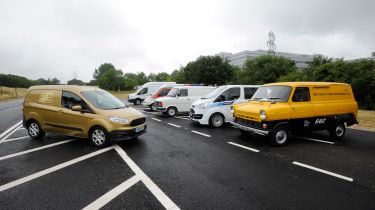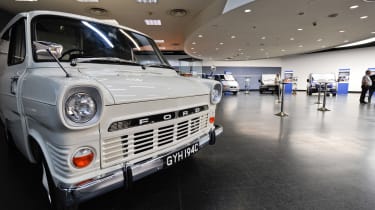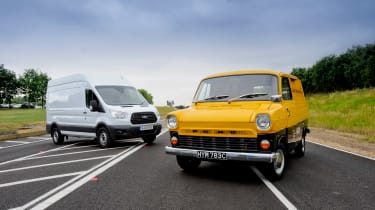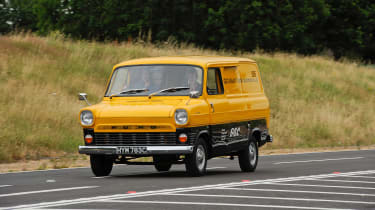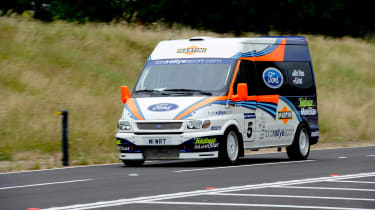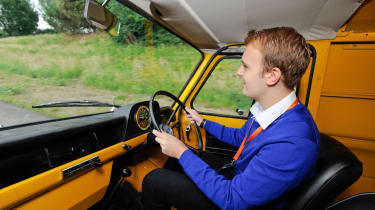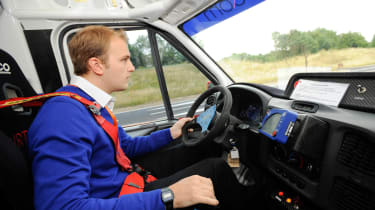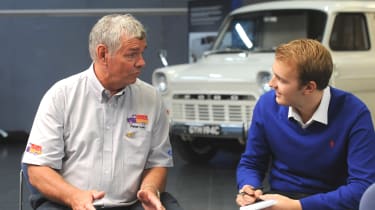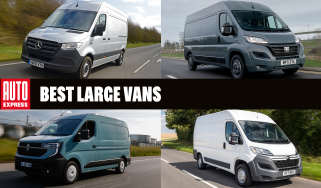Ford Transit: 50 years as the backbone of Britain
As Ford’s Transit celebrates its 50th birthday, we look at how it’s evolved into a van legend and meet the people behind it
The UK has had its fair share of vehicles that deserve a place in motoring history, but few have had the same impact on the world as the Ford Transit.
Surely no one could have predicted the longevity and success of a vehicle that first rolled off the production line on 9 August 1965? Since then, eight million Transits have been sold worldwide and the range has been expanded to encompass four models.
• Read all of our van reviews here
The Courier, Connect, Custom and Transit now make up the small-to-big van line-up with 600,000 a year built worldwide. It’s a far cry from the early days.
Auto Express met two of the workers who played a vital role in the development and production of the Mk1 Transit to find out its story – right from its birth as Project Redcap.
Brian Eckersley, now 78, worked in product planning and met Peter Best, 77, on the first day at the Transit office back in 1964. The pair, who are still close friends today, were part of the team run by Ed Baumgartner, the man generally recognised as the godfather of the Transit. He was responsible for keeping the project on track until launch, and so Brian and Peter were tasked with keeping an eye on a huge red book that listed all the parts and costs so they could guarantee the new project would be on time and on budget.
Of course, it wasn’t all plain sailing. Brian recalls: “They showed us the first clay model and I thought it was quite an ugly-looking thing. It was in dark green and looked like something from the US Air Force.”
Fortunately, the design of the van evolved – as did the Project Redcap name. The new model was due to replace the outgoing Thames vans. A naming convention had been established with the Ford D Series trucks already on sale, so Ford’s UK arm decided to call the new model the V Series. That was until a visit from the then-new Ford managing director, William Batty, just before the van’s launch.
Batty arrived in the UK and requested he drive the new V Series and its German twin – the Taunus Transit. Internally, the two vans were worlds apart because the UK and German supply chains were totally different, but they were virtually identical on the outside.
Brian says: “Bill Batty asked me ‘why the different names for what are, in essence, identical products?’ and told me it was a ridiculous state of affairs.
“He said ‘we’ve got a wonderful name synonymous with transport. Why are we not using it?’. He decided there and then that he wanted the Transit name to be used in the UK.” It was a wise decision.
So the famous name was born – but the troubles didn’t end there. The release date for the Transit had to be held back to wait for the Ford Corsair to hit the market. Brian reveals: “The Corsair had the same engine as the Transit and we didn’t want the Corsair to be known as having the same engine as a van. Instead the Transit could be billed as having the same engine as a car.”
When the Transit finally made it on to the road, it cost just £540, and success was almost immediate. Around 100,000 were built in 1965 and it started to give competitors a hard time straight away. “At the start I was surprised by its success,” admits Brian, “but when the orders came in you could see it was taking off. Even in Germany sales rocketed and the biggest competitor sales suddenly dropped off.”
The Transit continued to boom and evolve, with each facelift and model change moving the van on each time. A long-wheelbase version soon joined after a Ford boss requested a longer load bed to help carry his collection of antique carriage clocks.
Brian recalls a tale from the time before the LWB. The shorter van was lined up to carry the coffin of distinguished French war general Charles de Gaulle before his funeral.
De Gaulle was so tall that his coffin barely fit into the load area. The longer model couldn’t come soon enough.
While the coffin of de Gaulle might be one of the more unusual things to fill a Transit, there’s no doubt its huge size has been vital to its success, with the van helping to shift people, possessions and everything in between. Rather more infamously the Mk1 was the chosen vehicle for bank robbers and other criminals who found themselves in need of large, quick transport.
Just as the shape and design has changed, so has the performance. The load bay volume is now 15.1m3 – up from 7.4m3 in the original. Power output has almost quadrupled and payload weight is up by half a tonne.
It’s now the backbone of British business. The name Transit is synonymous with any large van and the white colour gave birth to the “white van man” tag. Some believe white was chosen to make it stand out, but that’s not that case. It was picked to keep drivers cool in the absence of air-conditioning. Arthur Molyneaux, a colleague of Peter and Brian, found that white vans were cooler in the sun.
Arthur, Peter and Brian epitomise the working man image of the Transit. A full 50 years after overseeing the birth of the Transit, Brian sums up the journey, telling us: “We knew more about the vehicle than anybody else and when you see them today, and how far they have come on, it’s great. I feel quite humble.”
We drive Transit generations
What better way to mark the legendary Transit’s golden anniversary than drive examples from down the years? Auto Express headed to Dunton Technical Centre in Essex – home of the Transit – to test the oldest, craziest and latest vans Ford has produced.
Our journey started with the 1965 version, which had no seatbelts, vague steering and non-existent brakes. The gearshift wasn’t easy, either. Still, it was hard not to fall in love with it – which we also did with the Mk2. Both whetted our appetite for something more radical, and it came in the rally version.
The three-point safety harness, bucket seats, hi-tech dash and full-on Colin McRae Martini Racing livery certainly enhanced the driving experience.
We also tried out the newest Transit and its Courier brother – and the difference between these and the early vans is stunning. Our quick blast through Transit history shows the 50 years have been well spent by the 4,000-strong team of Ford designers, engineers and technicians now working at Dunton.
1965 TRANSIT MK1
Earliest Transit had vague brakes and not much safety kit, but even now retains a certain charm.
2000 RALLY TRANSIT
This was one of the hi-tech vans the Ford World Rally team used to chase Colin McRae’s Focus from stage to stage in 2000.
2015 TRANSIT
White van man has things easy these days, with latest model featuring luxurious seating, air-con and vast cargo area.
How Transits become collector’s items
The current Transit Van Club was started 10 years ago, and founder member Peter Lee is the driving force behind all things Transit-related.
Peter worked on the original van, making gearboxes in the late sixties, and since then he’s been intrinsically linked to the Ford. He explains: “Originally, if a Transit was damaged during production it would be sold, and I bought one of these and repaired it.
“I was a hippy so I took it to Spain and lived out of the back of it for 13 years in a commune. I became Mr Transit because the people we lived with stuck stickers all over it.”
When Peter returned home he took his stickers off and saved them – that turned into a collection. “I’ve now got about 25,000 items and 13 Transits,” he says.
Most are personalised, including one that is kitted out with a full bar in the rear. However, his favourite is the original. Peter explains: “It’s nostalgic because I worked on it. The changes now are amazing. It’s like the difference between a spoon and a rocketship; there’s simply no comparison.
“Originally it was a brick and you paid for extras like seatbelts. Now a van has everything – even Bluetooth.”
Prices have rocketed, too. When Peter started the club, classic Transits sold for £1,000; now that’s closer to £25,000. “We’re seeing a high standard of classics coming into the club – we’ve got 1,500 members now,” he says.
Have you ever owned or driven a Ford Transit? Tell us about it in the comments section below...
Find a car with the experts
